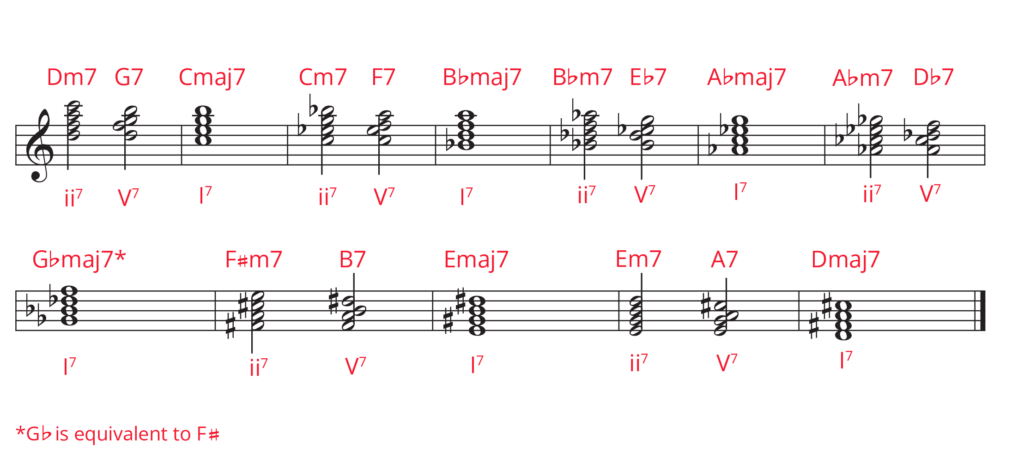
The 2-5-1 chord progression is an essential musical concept. It’s most common in jazz, but it can be found in pop, classical, and other styles of music too. Learning this musical building block will help you understand harmony and add creative flair to your playing, no matter the genre you choose.
Table of Contents:
Get exclusive interviews, fascinating articles, and inspiring lessons delivered straight to your inbox.
The 2-5-1 chord progression (sometimes called the ii-V-I) is an ordered set of three chords built on the second, fifth, and first notes of the key.
Let’s take a step back and break that down. Here’s a C major scale. We’ll assign a number to each note of the scale:

Next, let’s build a chord on each note of the scale. To keep things simple, we’ll use triads for now. All we’ll do is stack thirds on top of each note. The chords we’ll end up with are called diatonic chords. Diatonic chords are chords that occur naturally on the C major scale.

Notice that some chords are major and some are minor or diminished. We can indicate minor (and diminished) chords with lowercase Roman numerals.
Now, let’s take the ii, V, and I chords. If we put them together, we get a 2-5-1 chord progression:

The 2-5-1 already sounds very nice, but we can add more depth to it by adding a seventh to each chord. This creates major and minor seven chords. Here’s an example in C major:

One way to get familiar with the 2-5-1 is to recognize it by ear. Here are some songs that use this handy progression.
The jazz standard “Autumn Leaves” is an excellent example of the 2-5-1 in jazz. The entire song is practically built on 2-5-1s. Take a look at the chord chart and see if you can find them. Hint: The quality of each chord doesn’t need to match the minor-dominant 7th-major pattern perfectly; it’s the root movement that counts.
The Maroon 5 song “Sunday Morning” is a fantastic introduction to the 2-5-1 chord progression because it uses 2-5-1s over and over (and in C major too!). This gives the song a relaxed, jazzy sound perfectly reminescent of lazy Sunday mornings. (P.S.: We have a tutorial on this song here.)
You can find the 2-5-1 in classical music, often as a way to end a longer progression. For example, here’s a section of Bach’s Brandenburg Concerto No. 2 in F Major. (Robert Hutchinson does a phenomenal job of explaining this progression here, the larger of which is the Circle of Fifths progression.)
2-5-1s can be used to reharmonize songs. By throwing 2-5s into chord progressions, we can make a song sound “jazzier,” instantly elevating it from a basic performance to a sophisticated one. Here’s an example:
In our Piano Bench episode, Kevin Castro demonstrates using 2-5-1s in major keys with an example from “Happy Birthday.”
The beginning of “Happy Birthday” is rather simple. All we do is bop between the I and V chords. In C major, that’s the C and G major chords.

Now focus on that last C chord. We’ll treat it as our “target chord” and use the ii and V of C major to approach it.
In other words, we’ll chuck in a 2-5-1:

Try this out on your piano. The ii-V adds a layer of richness to an otherwise simple progression, doesn’t it? This is a common reharmonization method that jazz pianists use, and it’s a cool trick to pull off in parties 😉
The 2-5-1 chord progression works similarly to minor keys. But let’s review the diatonic chords in a minor scale first. Here is the C minor scale with diatonic chords:

If we take the ii, the V, and the i from this set, we create this:

Notice that we raise the B-flat to a B on the V chord. That’s because raising the seventh note of a minor scale (B-flat in our case) creates a more resolved sound.
Ideally, you want the ability to spontaneously throw 2-5-1s into whatever music you’re playing. For example, if there is an Fmaj7 coming up, you can chuck a Gm7 (ii7) and a C7 (V7) in front of it.
Getting to this level requires practice. Kevin practiced 2-5-1s for three months until he got to this point. What he did was practice 2-5-1s in every key by moving down step by step. Here’s what that looks like:

Then, you’d start the cycle again on C#m7.
Try not to rely on written notation when you practice 2-5-1s. It’s best to “calculate” the 2-5-1s yourself so you understand the concept.
However, having a cheat sheet can help in the beginning stages—if you want to double-check that you’re playing the right chord, for example. So, here are ALL the 2-5-1s in major and minor keys! Just try not to depend on this, okay? 😉
| Target Note (Key) | ii7 | V7 | I7 |
|---|---|---|---|
| C | Dm7 | G7 | Cmaj7 |
| C♯/D♭ | D♯m7/E♭m7 | G♯7/A♭7 | C♯maj7/D♭maj7 |
| D | Em7 | A7 | Dmaj7 |
| E♭ | Fm7 | B♭7 | E♭maj7 |
| E | F♯m7 | B7 | Emaj7 |
| F | Gm7 | C7 | Fmaj7 |
| F♯/G♭ | G♯m7/A♭m7 | C♯7/D♭7 | F♯maj7/G♭maj7 |
| G | Am7 | D7 | Gmaj7 |
| A♭ | B♭m7 | E♭7 | A♭maj7 |
| A | Bm7 | E7 | Amaj7 |
| B♭ | Cm7 | F7 | B♭maj7 |
| B | C♯m7 | F♯7 | Bmaj7 |
Minor Keys
| Target Note (Key) | iiø7 | V7 | i7 |
|---|---|---|---|
| C | Dm7♭5 | G7 | Cm7 |
| C♯/D♭ | D♯m7♭5/E♭m7♭5 | G♯7/A♭7 | C♯m7/D♭m7 |
| D | Em7♭5 | A7 | Dm7 |
| E♭ | Fm7♭5 | B♭7 | E♭m7 |
| E | F♯m7♭5 | B7 | Em7 |
| F | Gm7♭5 | C7 | Fm7 |
| F♯/G♭ | G♯m7♭5/A♭m7♭5 | C♯7/D♭7 | F♯m7/G♭m7 |
| G | Am7♭5 | D7 | Gm7 |
| A♭ | B♭m7♭5 | E♭7 | A♭m7 |
| A | Bm7♭5 | E7 | Am7 |
| B♭ | Cm7♭5 | F7 | B♭m7 |
| B | C♯m7♭5 | F♯7 | Bm7 |
Kevin Castro is a graduate of the prestigious MacEwan University with a degree in Jazz and Contemporary Popular Music, and is the Musical Director and touring pianist for JUNO-winning Canadian pop star, JESSIA. As your instructor at Pianote, Kevin is able to break down seemingly complex and intimidating musical concepts into understandable and approachable skills that you can not only learn, but start applying in your own playing. Learn more about Kevin here.


By signing up you’ll also receive our ongoing free lessons and special offers. Don’t worry, we value your privacy and you can unsubscribe at any time.
We use cookies for traffic data and advertising. Cookie Policy »